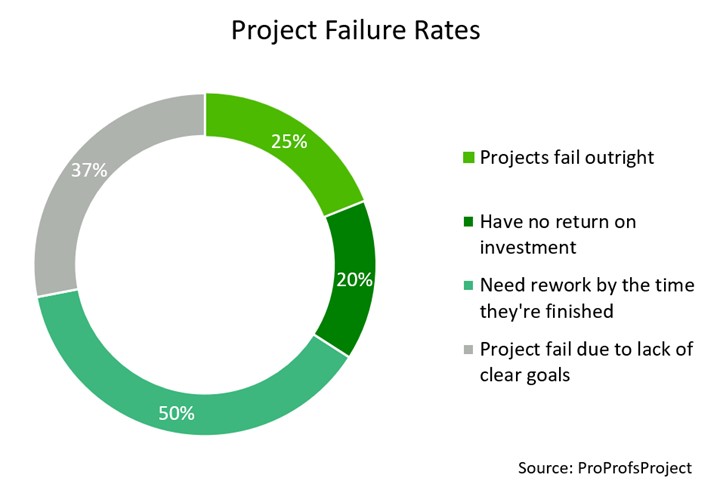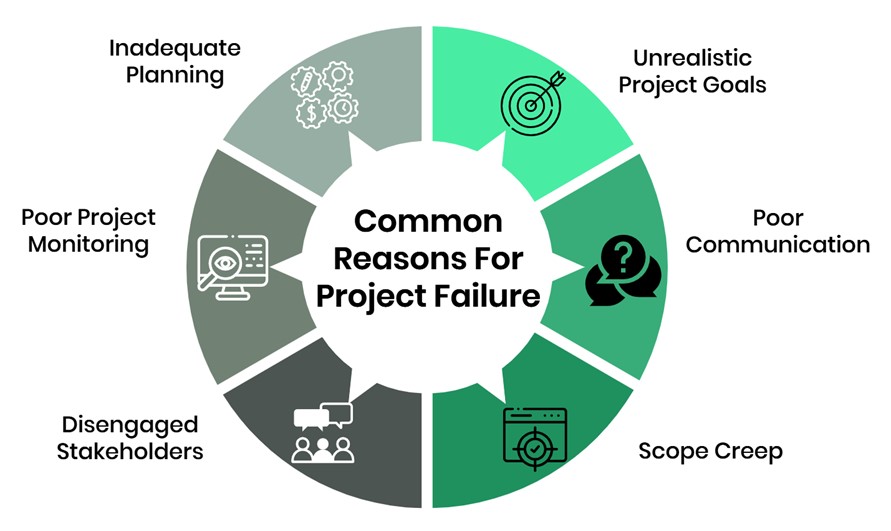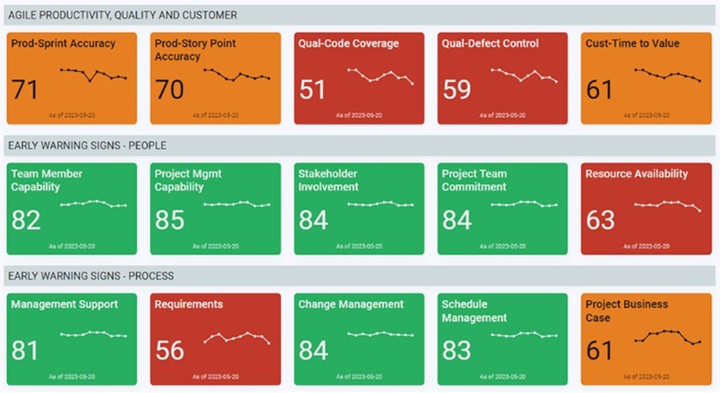
Projects do not become troubled overnight. Most of us have seen projects take the slippery slope from "green" to "yellow" to "red," and along the way, there are plenty of warning signs that can help you avoid failure. By not addressing early warning signs, you are setting yourself up for failure. Discovering these warning signs early will allow you to take corrective action and avoid disaster. Oversight of these cues could lead to a domino effect that eventually leads to project failure. In this article, we will discuss the importance of identifying early warning signs in projects, the types of early warning signs, how to identify them, and how to mitigate them.
What Are Early Warning Signs?
Early warning signs in project management indicate that a project is off track. Using modern predictive intelligence solutions, it is possible to identify these signs by regularly monitoring the project's progress and looking for any red flags. Some common early warning signs include scope creep, unrealistic deadlines, poor communication, a lack of team dynamics, unclear or changing requirements, resource constraints, technical problems, a lack of stakeholder buy-in, and unexpected events. By identifying these signs, project leaders can take corrective actions and improve the chances of project success.

Why It Is Important to Identify Early Warning Signs in Projects
Identifying early warning signs is essential to avoid project failure.They provide you an opportunity to act before it is too late. They help project leaders stay ahead and make informed decisions to prevent failure. Early warning signs also help project leaders identify potential risks and take proactive measures to mitigate them. You cannot avoid problems that you cannot see. Therefore, to get a complete overview of your project, you need to use predictive intelligence solutions to monitor and measure every aspect of the project to ensure nothing falls through the cracks. This will ensure there are no more surprises that hinder project success.

What Are Early Warning Signs of Project Failure and How to Mitigate Them?
There are many different early warning signs of project failure. Some of the most common include:
- Unclear or Unrealistic Project Goals: When project goals are not clearly defined or are unrealistic, it can lead to confusion and a lack of direction. To mitigate this, project leaders should ensure that goals are specific, measurable, achievable, relevant, and time-bound (SMART) and regularly communicate and align them with stakeholders.
- Poor Communication in the Workplace: Ineffective communication can result in misunderstandings, missed deadlines, and rework. To address this, project leaders should establish clear communication channels, encourage open and transparent communication, and ensure all team members are on the same page.
- Scope Creep: Scope creep occurs when the project scope expands beyond what was initially agreed upon. This can lead to cost overruns, schedule delays, and quality problems. To effectively manage scope creep, project leaders should establish a robust change control process, thoroughly evaluate and document any requested changes, and assess their impact on the project's timeline, budget, and objectives.
- Lack of Stakeholder Buy-In: If project stakeholders do not support the project or are not involved in the decision-making process, it can hinder progress and lead to project failure. To address this, project leaders should engage stakeholders early on, involve them in project planning and decision-making, and regularly communicate project updates and progress.
- Inadequate Planning: Poor project planning can result in resource constraints, missed deadlines, and failure. To mitigate this, project leaders should invest time in thorough project planning, including defining project objectives, creating a detailed project schedule, identifying and allocating resources, and conducting risk assessments.
Project leaders must first prioritize which early warning signs to address based on their potential impact on the project's success. This can be done by assessing the severity and likelihood of each warning sign and prioritizing those that pose the highest risk to the project's objectives.
By identifying and addressing early warning signs, project leaders can increase their chances of project success.

How to Identify Early Warning Signs
The factors outlined in this article must be measured from existing project metrics and regular stakeholder input. These stakeholders are not just the project manager but must include the project sponsor, customer, vendors, team members, and anyone involved in the project definition, performance, or the end beneficiaries. One such way this can be accomplished is with a predictive intelligence tool such as TrueProject. TrueProject is a SaaS solution that provides management control and oversight for all your projects. It monitors your projects for risks and early warning signs and allows you to review your KPIs and proactively address potential problems. It gathers information from all project team members, enforcing best practices and providing analytics that give you insights weeks or even months in advance to avoid project challenges and failures. TrueProject's predictive intelligence can be a valuable tool for organizations that want to improve their project success rate. By identifying and mitigating early warning signs of project failure, organizations can improve their chances of delivering projects on time, on budget, and to the required quality standards. Seamlessly integrated within project management practices, TrueProject deciphers data, forecasts potential risks, and offers actionable insights.

Conclusion
The ability to discern and address early warning signs is emblematic of astute leadership. As vanguards of innovation, project leaders shoulder the responsibility of project trajectories. By deciphering these cues, they navigate potential stumbling blocks and usher in progress. Early warning signs, when diligently identified and acted upon, fuel the journey toward project success.
Leveraging TrueProject will serve as the north star for project excellence. It empowers organizations, monitors for early warning signs, and elevates project planning, decision-making, and accountability. By utilizing TrueProject's capabilities, project leaders unwind an avenue to excellence, seamlessly transforming potential obstacles into catalysts for transformative accomplishment.
More information on TrueProject at trueprojectinsight.com

About the Author:
Nisha Antony is an accomplished Senior Marketing Communications Specialist at TrueProject, a leader in predictive intelligence. With over 16 years of experience, she has worked as a Senior Analyst at Xchanging, a UK consulting firm, and as an Internal Communications Manager on a major cloud project at TE Connectivity. She is an insightful storyteller who creates engaging content on AI, machine learning, analytics, governance, project management, cloud platforms, workforce optimization, and leadership.
Endnotes:
- David Miller. "8 Early Warning Signs of Project Failure & How to Avert Them." ProProfs Project: May 23, 2022. https://www.proprofsproject.com/blog/common-reasons-for-project-failure/
- Ricksoft. "Five Early Warning Signs of Project Failure and How to Resolve Them." Ricksoft: Oct 14, 2021. https://www.ricksoft-inc.com/post/five-early-warning-signs-of-project-failure-and-how-to-resolve-them/
- Arsalan Qutbi. "Staying Ahead of the Game: The Importance of Early Warning in Project Management." LinkedIn: Mar 16, 2023. https://www.linkedin.com/pulse/staying-ahead-game-importance-early-warning-project-arsalan/





